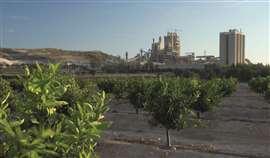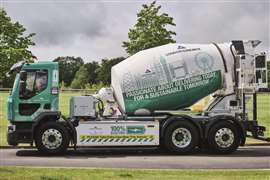Sustainable roadbuilding: How can we transform our transportation infrastructure?
07 August 2023
Infrastructure needs to become more sustainable and it needs to happen sooner rather than later. Catrin Jones looks at how the roadbuilding industry is making changes for a greener future.
As the world grapples with climate change and environmental degradation, sustainable practices are crucial in all aspects of our lives – and roadbuilding is no exception.
 Public road authorities are recognised as crucial in driving sustainability progress (Photo: AdobeStock)
Public road authorities are recognised as crucial in driving sustainability progress (Photo: AdobeStock)
Road building demands attention, as traditional methods contribute to carbon emissions, habitat destruction, and resource depletion. However, sustainable roadbuilding practices offer an opportunity to transform our transportation infrastructure into a catalyst for positive change.
Evaluating equipment
With reduced emissions a key driver, Hamm, a specialist in compaction equipment, has launched the HD+ 70 and HD+ 80 tandem roller models with a 55.4 kW engine that meets the exhaust emissions category UN ECE R96. These tandem rollers are designed for Tier 3 markets and are available as vibration, oscillation, or combination rollers.
Despite their compact size, Hamm says they offer exceptional driving and handling characteristics similar to the heavier rollers in the series. This makes them ideal for compacting construction sites efficiently, even in tight spaces.
Hamm says it recognises the importance of digitalisation in improving compaction quality. As a result, the manufacturer has equipped its machines with interfaces that allow for seamless integration with telematics systems, fleet management systems, and Smart Doc – an app for compaction control and documentation.
Technology for efficiency
One of the notable features available for the HD+ series is the Smart Doc app. The app utilises Bluetooth technology to transmit essential operating data from the roller to a smartphone or tablet. Operators can monitor real-time compaction progress on their mobile devices, with the app linking the machine data with GNSS position for precise location information.
Moreover, the Smart Doc app generates compaction reports in PDF format, making it suitable for self-monitoring and continuous compaction control (CCC). Starting from autumn 2023, Smart Doc will also have the capability to consolidate data from all the rollers on a single construction site. This allows every connected device to display the overall compaction achieved by the team, enabling real-time monitoring for construction management. Ultimately, this integration of Smart Doc increases efficiency and improves the quality of compaction operations.
Hamm’s introduction of the new HD+ 70 and HD+ 80 models, along with integrating the Easy Drive operating concept and digital interfaces, represents a significant step forward in sustainable roadbuilding practices and demonstrates that manufacturers are willing to make the necessary changes to reduce emissions.
Alternative power
In addition to Hamm’s work on emission reduction, Dynapac released an electric paver at the end of 2022 after its debut at the construction machinery trade show Bauma. The company’s first electric paver model was released as part of its Z.ERA programme to move towards machines with fossil-free drives.
Described as “a glimpse of things to come”, the new eCity SD1800W e wheeled paver has a maximum paving capacity of 350 tonnes an hour and offers a paving width of 4.1m with the screed extended.
 The eCity Paver SD1800W e paver was presented at Bauma 2022 (Photo: Dynapac)
The eCity Paver SD1800W e paver was presented at Bauma 2022 (Photo: Dynapac)
It can operate for up to four hours on a single charge, depending on application, and has a paving speed of 25m per minute and a top travel speed of 15kmh.
The eCity SD1800W e features a similar design to that of its diesel powered SD1800W counterpart and, in terms of performance, is suitable for inner-city applications, such as road assignments for bicycle lanes and repair works.
“Recent developments in e-mobility have shown that the new generation of electric batteries can compete with their conventional, fossil-fuel-run counterparts,” said Dynapac.
According to the manufacturer, the eCity machine’s battery can be charged from 5% up to 80% in three hours using its CE-compliant Type 2 plug for 400V, 6-32A, 1.4 to 22.0kW AC power outlets.
Although “charging while working is not possible, one can pre-heat the screed with the charger (with Type 2 AC or CCS2 DC) while waiting for the material to arrive, thus preserving the battery level,” said Dynapac.
Recycled materials
The machinery used on road projects has a significant impact but what more can be done? Engineers at LJMU have initiated a groundbreaking project aimed at significantly minimising the environmental impact of Liverpool’s roadways.
By harnessing innovative technologies developed within the School of Civil Engineering and Built Environment, the city will be able to construct new roads and pavements using recycled materials from demolished infrastructure.
Professor Hassan Al Nageim, the leader of the Novel and Bio-Based Materials Technology Group at LJMU, explained, “This approach will result in substantial cost savings in both the construction of new road structures and reconstruction expenses. Moreover, it will lead to a reduction in CO2 emissions and minimise disruptions to infrastructure users.”
In the UK, Liverpool City Council has secured €4.7m funding from the Department of Transport, through the Live Labs 2: Decarbonising Local Roads competition. This funding will initiate three demonstration projects in Everton, Picton, and Belle Vale, primarily focusing on incorporating environmentally friendly practices throughout the road development process, from design to construction.
The city will collaborate with LJMU and Colas to develop the necessary material processes for implementing this initiative.
Solid progress
Similarly, Cemex and WtEnergy are looking at the materials used in road projects and how using building waste could be the new future. The companies have been granted €4.4 million by the European Union for their innovative waste-to-fuel technology project at the Alicante cement plant in Spain. The European Union hailed this project as the first of its kind in the cement industry.
 The technology replaces fossil fuels with synthetic gas derived from waste and byproducts from other industries (Photo: Cemex)
The technology replaces fossil fuels with synthetic gas derived from waste and byproducts from other industries (Photo: Cemex)
Fernando A. González, CEO of Cemex, emphasised the importance of innovation in the company’s mission to decarbonise operations and lead the industry towards a more sustainable future. He highlighted that products and solutions contribute to the construction of vital structures, and technologies like this one ensure cleaner, lower-carbon, and more circular construction practices.
The technology, known as “Clyngas,” developed by WtEnergy, replaces fossil fuels with synthetic gas derived from waste and byproducts from other industries. This substantial reduction in carbon footprint offers significant environmental benefits for cement operations.
The Clyngas project has the potential to reduce more than 400,000 tonnes of CO2 equivalent emissions over a decade at the Alicante plant. The grant committee commended the project for its strong innovation, reliability, and the advancements it brings in gasification technology.
‘Greenest road ever built’
Also in the UK, infrastructure specialist Balfour Beatty has been awarded a huge roadbuilding contract within the UK’s Lower Thames Crossing project.
The deal, worth around €1.37 billion, will see the company construct more than 16km of roads north of the proposed river crossing, including a crucial connection with the M25 motorway around London. The UK Thames Crossing is said to be the greenest road ever built in the UK.
The scope of the contract, awarded by the UK’s National Highways agency, also includes the construction of 49 structures, including bridges and viaducts, many of which will be built offsite, using modular construction techniques.
Balfour Beatty said it plans to manufacture structures in a factory environment, reducing the requirement for material deliveries to the site and subsequently reducing the project’s carbon emissions. Construction work should start in 2024, with completion expected between 2029 and 2030.
At the peak of construction, Balfour Beatty will directly employ around 2,000 workers, with some 150 of these to be apprentices, graduates and trainees.
 Computer generated image of Lower Thames Crossing A13 junction (Photo: Balfour Beatty)
Computer generated image of Lower Thames Crossing A13 junction (Photo: Balfour Beatty)
The company will also establish training and upskilling programmes for staff and expects to spend in the region of €570 million with local business and supply chain partners.
Leo Quinn, group CEO of Balfour Beatty, said, “The Lower Thames Crossing is a significant scheme - one that will stimulate local, regional and national economic growth, create employment opportunities and new, sustainable methods of construction for the future of our industry.
“Our deep domain knowledge and long-standing history in complex road construction, acquired through many years of successful delivery on behalf of National Highways, makes us ideally positioned to deliver this project to the highest standard.”
Building greener roads
In other news, the Global Infrastructure Initiative (GII) recently held its second small-group discussion on the future of roads on June 15, 2023. The roundtable brought together road developers and operators, Intelligent Transportation Systems (ITS) institutions, and public sector decision-makers to delve into the topic of greener roads.
Addressing Scope 3 GHG emissions emerged as a critical challenge. Scope 3 encompasses emissions that are not produced by the company itself and are not the result of activities from assets owned or controlled by them, but by those that it’s indirectly responsible for up and down its value chain.
Typically, road infrastructure players find that more than 90% of their total emissions come from Scope 3, highlighting the need for collaboration with suppliers, road users, authorities, and grantors. Despite progress in reducing Scope 1 and 2 emissions, participants agreed that tackling Scope 3 is complex and requires strong collaboration with public authorities. Leadership capabilities and effective stakeholder management were emphasised as essential for advancing sustainability initiatives.
Public road authorities were also recognised as crucial in driving sustainability progress. A survey conducted during the discussion revealed that 42% of participants considered regulatory uncertainty to be the biggest obstacle to achieving green roads. One executive noted that decisions such as switching from tolling to free-flow required agreement from the concessionaire. However, participants also acknowledged that Europe has the potential to establish a common regulatory framework and lead globally in this area.
The collective will to overcome challenges was highlighted as vital.
The roundtable discussion sheds light on the challenges and opportunities associated with creating greener roads, emphasising the need for collaboration, regulatory clarity, and innovative approaches that will lead to a sustainable future.
Reuse, reduce, recycle

A €389 million deal has been approved for the construction of a fourth lane on the A1 motorway between Lodi and Milan.
The Lombardy Region, the federal Ministry of Infrastructure and Transport, and motorway operator Autostrade per l’Italia, ASPI, have signed a memorandum of understanding agreement.
As part of the agreement, approximately 16 hectares of trees will be planted, 3.4km of noise barriers will be installed, and a network of cycle paths will be developed. Moreover, up to 75% of the materials from excavation work will be recycled and reused.
Second of its kind in the UK

McPhee Mixers has supplied a 26-tonne electric concrete mixer to Aggregate Industries’ London Concrete subsidiary. This vehicle, based on a Renault Trucks chassis, marks the second of its kind in the UK. Tarmac had previously tested a similar mixer at its Washwood Heath plant in Birmingham.
The newly acquired mixer will be utilised by London Concrete to transport ECOPact and Dynamax concrete products, aiming to provide the utmost in environmentally friendly concrete supply.
Aggregate Industries sustainability director Kirstin McCarthy said: “Our distribution network is one of the largest in UK construction and will play an important focus in our efforts toward net zero.
“I’m therefore incredibly excited that we are able to lead the way in electric concrete mixer innovation and distribute our green construction solutions to customers across the capital with virtually zero footprint.
STAY CONNECTED



Receive the information you need when you need it through our world-leading magazines, newsletters and daily briefings.
CONNECT WITH THE TEAM








